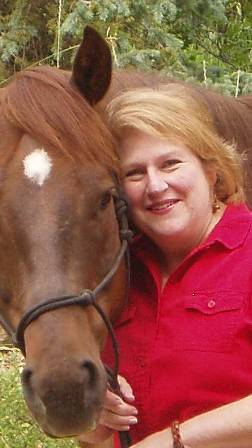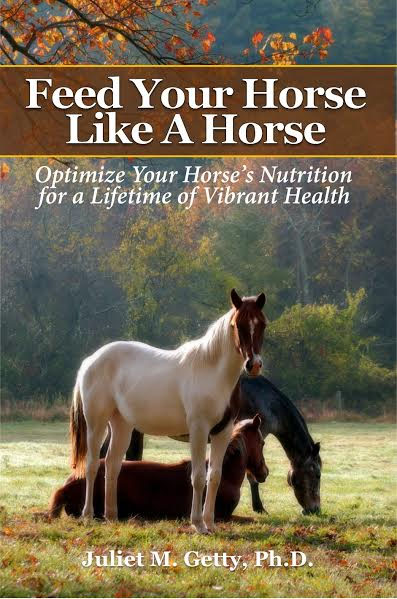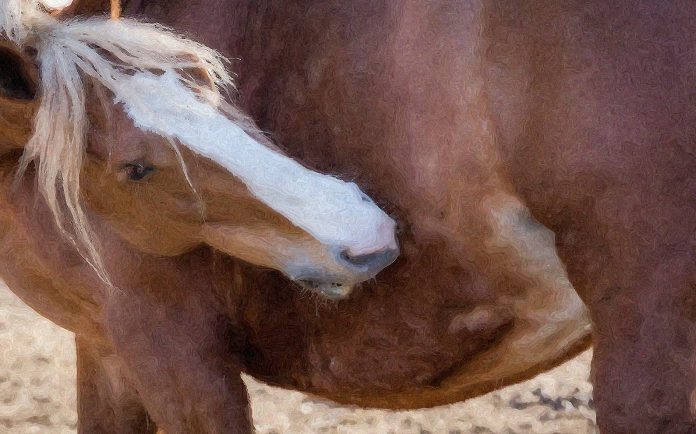Is Your Horse on Bute? Consider Something Other than Omeprazole to Prevent Ulcers
by Juliet M. Getty, Ph.D.
Bute (phenylbutazone) is the most commonly used NSAID (non-steroidal anti-inflammatory drug) for pain resulting from injury to the joints and feet. But while you’re relieving your horse’s pain, you may be putting him at risk of developing an ulcer. Here’s why…
Bute functions by blocking the cyclo-oxygenase (COX) enzymes responsible for converting arachidonic acid (a fatty acid) to prostaglandins, some of which contribute to pain and inflammation. There are two types of COX enzymes, COX-1 and COX-2, which differ in their impact on your horse’s digestive system. COX-2 is the one we want to inhibit because it is involved in producing the problematic prostaglandins. COX-1, however, is a beneficial enzyme that maintains a healthy gastrointestinal lining and also promotes proper blood clotting. Unfortunately, bute blocks both of these enzymes, alleviating your horse’s discomfort (because it blocks COX-2), but making the mucosal lining of the stomach more vulnerable to stomach acid (by blocking beneficial COX-1), potentially leading to ulcerations anywhere along the digestive tract.[i]
Bute disrupts the natural surface barrier within the stomach’s mucosal lining. Within this lining is a fatty bilayer made up of two rows of molecules called phospholipids. The outer portion is hydrophilic (attracted to water) while the inner portion is hydrophobic because of its fat content. Because bute inhibits COX-1, it causes the inner hydrophobic barrier to become hydrophilic, allowing acid to permeate the mucosal lining, resulting in ulcerations.
To protect against ulcers, many veterinarians will prescribe omeprazole
Produced by Merial, omeprazole goes by the brand names of the full-strength GastroGard® used to treat ulcers or the lower-dosed, UlcerGard®, used to prevent ulcers while the horse is receiving bute. There is some justification for using this. Omeprazole is a proton-pump inhibitor which blocks the final step of acid production within the stomach. Since the protective mucus lining of the stomach may be compromised by bute, it becomes vulnerable to acid. Omeprazole reduces the acid content of the stomach, thereby preventing the formation of ulcers.
But there are real concerns with continued use of omeprazole. You may not be aware that:
- Sudden discontinuation of omeprazole can cause a rebound acid effect, at increased levels, making your horse more vulnerable to ulcer formation.[ii]
- Omeprazole can lead to malnutrition because stomach acid is necessary to start protein digestion and absorption of key minerals.
- Omeprazole doesn’t protect against ulcers that may show up in the colon.
Allow your horse’s stomach to do its job
Your horse’s stomach is meant to produce hydrochloric acid (HCl). HCl is needed to activate pepsin, an enzyme that starts to break down large protein molecules so they can later be completely digested in the small intestine down to individual amino acids. Amino acids are the building blocks of the proteins found throughout your horse’s body. If the protein in your horse’s diet is not adequately digested, amino acids will not be available to produce and repair body tissues. Furthermore, minerals found in feedstuffs are typically bound to proteins, making protein digestion necessary in order for these minerals to be released and absorbed.[iii]
Nevertheless, when COX-1 is inhibited, acid becomes the enemy because it can seriously damage the compromised mucosal layer throughout the stomach and the entire gastrointestinal tract.
Turning off stomach acid is not the answer
Well, it’s an expedient solution. And it relieves the symptoms, but it doesn’t truly undo the damage that bute has inflicted. Think about it… the lipid bilayer has been damaged by inhibiting COX-1, making it vulnerable to acid. Removing the acid doesn’t take away the fact that the bilayer is damaged. Why not just prevent damage or repair it instead?
There are two important foods you can add to your horse’s diet that can prevent or repair gastrointestinal damage from bute:
- Lecithin plus apple pectin
- Colostrum
Researchers from the University of Texas[iv] Department of Integrative Biology and Pharmacology described this mechanism using human subjects on NSAIDS (in particular, aspirin and naproxen). They created a formula that combines the NSAID drug with phosphatidylcholine (PC). When PC combines with NSAIDs, it creates a complex that is more fat-soluble, thereby promoting its transit across the hydrophobic mucus layer of the stomach, with reduced surface mucosal injury, while not altering the efficacy or pharmacological activity of the NSAID. They also found that not only does PC significantly reduce gastrointestinal injury, but in some cases, it even eliminated gastrointestinal ulcerations.
Lecithin and apple pectin
Lecithin is the common term for PC. Other research indicates that lecithin is effective in providing protection and treatment of equine gastric ulcers.[v] PC is a naturally occurring substance; it is the most abundantly found phospholipid in animal and plant cell membranes, and is most commonly derived from soybeans, though can be derived from other plants. Chemically, it primarily consists of essential fatty acids, linoleic acid (omega 6) and alpha linolenic acid (omega 3), along with a molecule of choline (an essential B vitamin-like nutrient).
Apple pectin, when combined with lecithin, offers a synergistic approach in preventing and alleviating ulcers. Pectin is a water-soluble fiber which acts with lecithin to form a hydrophobic barrier on the gastric mucosal membranes, protecting them against the corrosive effect of HCl.[vi] Lecithin granules and apple pectin can be purchased in any health food store, or in bulk through online providers. I recommend feeding ½ cup of lecithin plus 2 Tablespoons of apple pectin with each dose of bute (for an 1100 lb horse). It can be mixed with any feed and is quite palatable. Another option is a lecithin/apple pectin supplement called Starting Gate (SBS Equine Products)[vii], which may be more convenient.
Colostrum
Colostrum has been shown to prevent stomach and intestinal ulcerations and also increase new, healthy cell proliferation.[viii] The Transforming Growth Factors (TGF) present in colostrum actually stimulate gastrointestinal repair and maintain the integrity of the epithelium layer of the gastrointestinal tract.[ix] I recommend 20 grams of colostrum per day (for an 1100 lb/500 kg horse) while your horse is receiving bute.
All horses, even healthy ones, can benefit from this nutritious food. Bovine colostrum is very low in lactose, making it appropriate for adult horses (who are naturally lactose intolerant). As a superfood, it is a natural source of nutritive factors that have a significant impact of on your horse’s recovery from a vast variety of ailments.[x] It has been used by adult humans and animals for hundreds of years with remarkable results. Its impact on the horse industry is starting to show promise, revealing itself as an amazing tool to help your horses maintain optimal health. Look for colostrum that is from a source that is harvested during the first few hours of lactation and has been processed at low temperatures.[xi]
Bottom line
Instead of adding omeprazole to protect against ulcers when you use bute for pain relief, consider adding lecithin and/or colostrum to prevent and repair bute’s potential damage to the gastrointestinal lining. Omeprazole turns off acid production which can lead to other health issues. Lecithin, apple pectin, and colostrum protect the delicate phospholipid bilayer that lines your horse’s digestive tract. Lecithin (phosphatidylcholine) is a naturally occurring phospholipid and can easily be added to the diet along with apple pectin. Bovine colostrum is also worth considering and has multiple benefits beyond ulcer protection. Both of these offer a solution without the potential side-effects that omeprazole can create.
This article updates and expands information in one of Dr. Getty’s previous Tips of the Month.
Juliet M. Getty, Ph.D. is an independent equine nutritionist with a wide U.S. and

international following. Her research-based approach optimizes equine health by aligning physiology and instincts with correct feeding and nutrition practices. Dr. Getty’s goal is to empower the horseperson with the confidence and knowledge to provide the best nutrition for his or her horse’s needs.
Dr. Getty’s fundamental resource book, Feed Your Horse Like a Horse, is now in  paperback as well as in hardcover, searchable CD and Kindle versions. All except the Kindle version are available at www.GettyEquineNutrition.com — buy the book there and have it inscribed by the author. Print and Kindle versions are also available at Amazon (www.Amazon.com); find print versions at other online retail bookstores. The seven individual volumes in Dr. Getty’s topic-centered “Spotlight on Equine Nutrition” series are available with special package pricing at her website, and also at Amazon in print and Kindle versions. Dr. Getty’s books make ideal gifts for equestrians!
paperback as well as in hardcover, searchable CD and Kindle versions. All except the Kindle version are available at www.GettyEquineNutrition.com — buy the book there and have it inscribed by the author. Print and Kindle versions are also available at Amazon (www.Amazon.com); find print versions at other online retail bookstores. The seven individual volumes in Dr. Getty’s topic-centered “Spotlight on Equine Nutrition” series are available with special package pricing at her website, and also at Amazon in print and Kindle versions. Dr. Getty’s books make ideal gifts for equestrians!
Find a world of useful information for the horseperson at www.GettyEquineNutrition.com: Sign up for Dr. Getty’s informative, free e-newsletter, Forage for Thought; browse her library of reference articles; search her nutrition forum archives; and purchase recordings of her educational teleseminars. Find top-quality supplements, feeders, and other equine-related items, at her online Free Shipping Supplement Store[xii]. Reach Dr. Getty directly at gettyequinenutrition@gmail.com.
[i] Banse, HE., and Cribb, A.E., 2015. Review of nonsteroidal anti-inflammatory drug selection in horses. AAEP Proceedings, volume 61, 532-536.
[ii] WebMD. Study: Acid reflux drugs cause acid rebound symptoms. http://www.webmd.com/heartburn-gerd/news/20090702/stopping-ppis-causes-acid-reflux-symptoms#1
[iii] Gerber, J., 2005. Improving Bioavailability of Minerals from Supplements: Can Chelation Help? Journal of American Chiropractic Association, 42(8), 6-11.
[iv] Lichtenberger, L.M., Barron, M., and Marathi, U., 2009. Association of phosphatidylcholine and NSAIDs as a novel strategy to reduce gastrointestinal toxicity. Drugs of Today, 45(12), 877-890.
[v] Geor, R.J., and Papich, M.G., 1990. Medical therapy for gastrointestinal ulceration in foals. Compendium on the continuing education for the practicing veterinarian, 12, 403-412.
[vi] Woodard, M.C., Huff, N.K., Garza, Jr., F., Keowen, M.L., and Andrews, F.M., 2014. Effect of pectin, lecithin, and antacid feed supplements (Egusin®) on gastric ulcer scores, gastric fluid pH and blood gas values in horses. BMC Veterinary Research, 10(Suppl.1), S1-S4.
[vii] Starting Gate can be purchased at http://gettyequinenutrition.biz/products/startinggate.htm
[viii] Playford, R.J., Floyd, D.N., Macdonald, C.E., Calnan, D.P., Adenekan, R.O., Johnson, W., Goodland, R.A., and Marchant, T., 1999. Bovine colostrum is a health food supplement which prevents NSAID induced gut damage. Gut, 44, 653-658.
[ix] Thapa, B.R., 2005. Health factors in colostrum. Indian Journal of Pediatrics, 72, 579-581.
[x] Getty, J.M., 2016. Colostrum – An exceptional superfood! Library at www.GettyEquineNutrition.comhttp://gettyequinenutrition.biz/library/colostrumanexceptionalsuperfood.htm
[xi] Colostrum, offered by ForeFront Equine, is available at http://gettyequinenutrition.biz/products/forecolostrum.htm






















































